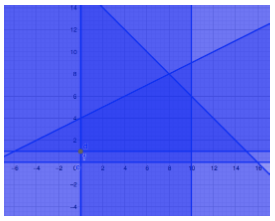13. Formulating Linear Programming Problems and Systems of Linear Inequalities
- Page ID
- 26457
The following topics are included in this series of four videos.
- Formulating a linear programming problem, example 1
- Formulating a linear programming problem, example 2
- Finding the feasible set and corner points for a system of linear inequalities, example 1
- Finding the feasible set and corner points for a system of linear inequalities, example 2
Prework
13.1. Formulate (but do no solve) the following linear programming problem. A florist makes 2 special bouquets. Both types consist of Japanese irises and tulips. Type I consists of 1 dozen tulips and 1 dozen Japanese irises. Type II consists of 2 dozen tulips and 4 dozen Japanese irises. The profit on each Type I bouquet is $8 and the profit on each Type II bouquet is $18. The florist knows that they sell at least 8 Type I bouquets each day, so they always make at least 8 of these each day. There are only 60 dozen tulips and 100 dozen irises available each day. How many of each type of bouquet should the shop make each day to maximize profit?
13.2. Graph the feasible region to the following system of linear inequalities: \(x+y\leq 16\), \(2y-x\leq 8\), \(x\leq 10\), \(y\geq 1\), \(x,y\geq 0\).
Solutions
-
Let \(x\) be the number of Type I bouquets and \(y\) be the number of Type II bouquets. Find \(x\) and \(y\) in order to maximize the daily profit \(P = 8x+18y\) subject to \(x \ge 8 \), \(x+2y \le 60\), \(x+4y \le 100\), and \(y \ge 0\).
-
The corner points are (0,1), (0,4), (8,8), (10,6), (10,1). The feasible region is the darkest area in the picture below (the up-pointing pentagon in the middle).


